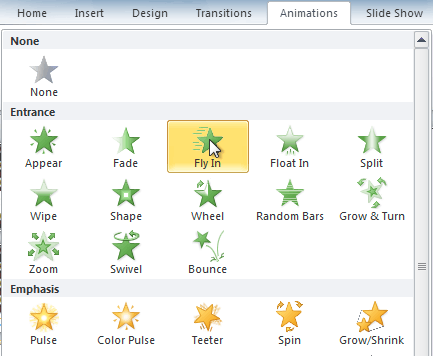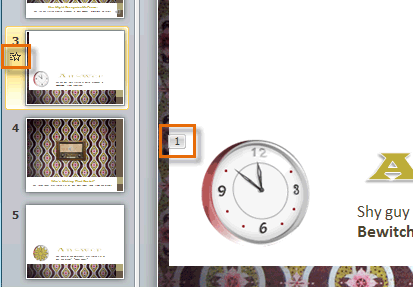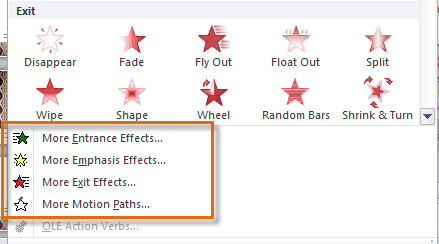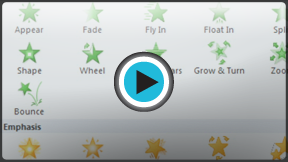PowerPoint 2010
Animating Text and Objects
Animating text and objects
PowerPoint offers a variety of animations you can use to enhance your presentation. Animations can be used to make text or objects appear on a slide, exit a slide, or emphasize the text or objects already on a slide. You can even use motion paths to create a customized animation.
The four types of animations
There are many different animation effects that you can choose from, and they are organized into four types:
- Entrance: These control how the object enters the slide. For example, with the Bounce animation, the object will "fall" onto the slide and then bounce several times.
 Entrance effects
Entrance effects - Emphasis: These animations occur while the object is on the slide, often triggered by a mouse click. For example, you can set an object to Spin when you click the mouse.
 Emphasis effects
Emphasis effects - Exit: These control how the object exits the slide. For example, with the Fade animation, the object will simply fade away.
 Exit effects
Exit effects - Motion Paths: These are similar to Emphasis effects, except that the object moves within the slide along a predetermined path, like a circle.
 Motion Paths
Motion Paths
To apply an animation to an object:
- Select an object.
- Click the Animations tab.
- In the Animation group, click the More drop-down arrow to view the available animations.
 The More drop-down arrow
The More drop-down arrow - Select the desired animation effect.
 Selecting an effect
Selecting an effect - The object will now have a small number next to it to show that it has an animation. Also, in the Slide pane, the slide will now have a star symbol next to it.
 The number and the star indicate that an effect has been added
The number and the star indicate that an effect has been added
At the bottom of the menu, you can access even more effects.
 More animation effects
More animation effectsEffect options
Some effects will have options you can change. For example, with the Fly In effect, you can control which direction the object comes from. These options can be accessed from the Effect Options command in the Animation group.
 Viewing the options for the Fly In effect
Viewing the options for the Fly In effect






